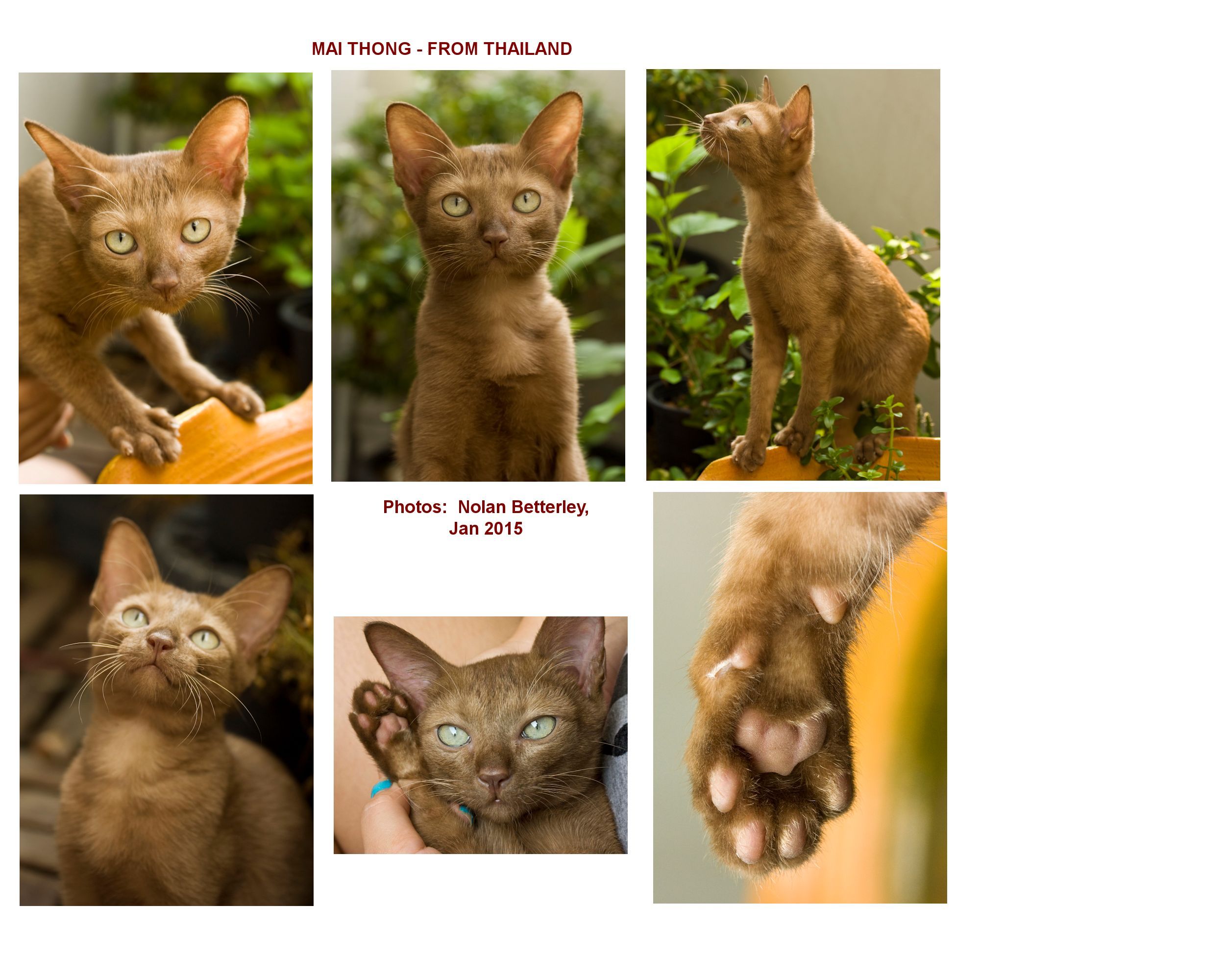
MOCHA COLOUR IN THAI CATS
Mocha is a colour found in cats of Thai descent. The dilution factor hasn’t been genetically identified, but appears to be part of the albino series and has been tentatively given the symbol "cm". In Thailand, this colour is being developed in the Bangkok breed, a natural Thai breed which can have blue, aquamarine or odd eyes.
The first of the mocha cats to be identified is Mai Thong. In January 2015, I received information and photos of a native Thai cat that TIMBA hoped to use in the Suphalak breeding programme. Nolan Betterley lives in Thailand and is working on the breeding project to resurrect some of the rare cats that are described in the ancient cat poem manuscripts. Breeders working on the Suphalak, which is a solid (i.e. no Burmese pointing) chocolate self, have searched all over Thailand to find cats suitable to be used in the breeding program. They found cat, Mai Thong, aged approx 7 months, on the street. Nolan hoped that she was either cinnamon or lilac (these are recessives). DNA was tested at UC Davis and came back as aa BB CC DD (Non-Agouti, Black, No Colourpoints, No Dilution), which should produce a black cat. However Mai Thong is very obviously not black, but has an orangey colour. The gene candidates are a non-extension gene (since Russet Burmese exist) or a different form of dilution.
Below is the albino series in cats, from most dominant to most recessive. DNA testing found that “mocha” is an allele of the “C” locus and is co-dominant with both cb and cs (and can't be shown in strict order of dominance in a list). Temperature-sensitive albinism in cats is caused by tyrosinase (TYR) mutations. For the molecular genetically minded, it is a cytosine deletion in the TYR gene. Cat fanciers refer to it as the "C" locus (a sort of genetic "address"). Mocha is not a separate modifier of C.

The remaining 3 cats that failed the test for the Suphalak breeding programme were also street cats; two were brown and one was tortie. They are now in the USA with two different breeders. The plan was to mate them and test offspring, but this has not happened. Doug Schar has the tortie sister. The owner of the other 2 cats has not allowed access to a male sibling for test-mating. UC Davis found no mutation of the TYR gene for these cats. Unfortunately, no other labs appear interested in following up to see what mutation is present. I will let Doug Schar explain in his own words (personal correspondence April 2019):
“In 2015, Nolan Betterly sent me a Queen and her three kittens from Thailand. They were rescues. When I had the four cats coat colour tested at UC Davis, the three daughters all tested out as BB Ccb Dd. I called Davis and reported that the cats were not black, per the test results, and were in fact very brown. Davis proceeded to ignore me in every possible way. To this day, they have not responded to my numerous queries about this anomalous result. Because Davis refused to comment on how their test could be wrong, and I was quite mystified, I sent swab samples to University of Langford, i.e. the vet testing lab. Langford were infinitely more helpful. Once they tested the cats, saw their photographs, they offered their very considered opinion. They told me that clearly the C that appeared on the test results was a false C and most probably indicated a new albinistic coat color mutation as of yet described. And, they added that as there was no money for such research, it was likely to remain unidentified. Langford could not have been more professional and helpful.
From that time forward, Nolan Betterly and I have worked on the "black not black" project in tandem. He in Thailand and me at my cattery in Washington, DC. Using the tortie daughter from the original four cats Nolan sent me, I created a line of cbcm cats and have maintained it ever since.
Lori Luckenbough imported two cats from Thailand, and to her surprise, these two very brown cats also tested at UC Davis tested as black cats. The imported cats, Amano and Marin, produced several litters of cats. Some cbcb, some cbcm, and some cmcm. One of which I believe ended up with Janet Poulson. I dont know anything about what has happened to the other cats. But, I have several cats that descend from the Amano x Marin mating in my line.
As a result of using these two separate lines of cbcm cats, I now have a line of cmcm cats. (or BB CC DD cats as they appear in coat color testing.) They most assuredly bear little resemblance to cbcb or cscs or cbcs cats. They have their own unique color for sure. While the term Mocha is is sort of appropriate, when you see the cats, they really are more pink than mocha. It is a hard color to describe. Im not convinced mocha is the best way to describe them. My cat helper calls them the strawberries because she thinks they are a strawberry color. With a strong line of cmcm cats in hand, I am now breeding the cmcm cats with cats that carry chocolate and blue. In the near future will see what what bb cmcm DD and BB cmcm dd cats look like!
In a parallel track, Nolan has been isolating cm carrying cats and has developed his own line of cmcm cats in Thailand. His process there started with the cat you mentioned in your article, and has spread to a nationwide search for cats that appear to be cm or cm carrying cats. He no doubt now has the largest and most genetically diverse group of cmcm cats.
Nolan and I have decided that the cats should be called "Bangkok Cats". We came to this as the cats Nolan rescued and sent to me, the first cats to be identified as "black not black cats", were found in Bangkok. We also believe the Thai people keep having their cats misappropriated by westerners and given names that have no bearing on their Thai origins. (Burmese cats, Tonkinese cats, etc.) being two notable examples. So, we call them Bangkoks. If you want to see a photo array of them, you can visit The Thai Cat Center and click on the Bangkok tab. I have to update the side show because I have more photos to add.
I am a researcher by nature and training (PhD Exeter). Trying to get to the bottom of this "black not black" phenomena, I did as detailed a research job on the cats coming into the west from Thailand into Victorian England as possible. In several of the early accounts of Thai cats in England, a dun colored cat was described. When the brown variant (cbcb or cbcs) was separated from the "Siamese" variant, it seems initially the standard was for a brown cat with blue eyes (cmcm) but later was changed to a brown cat with gold eyes (cbcb). All this to say, I think these cats have been around since the earliest importation. I think they were just bred out as being neither this nor that. I think they were the cats the old books described as "muddy" colored.
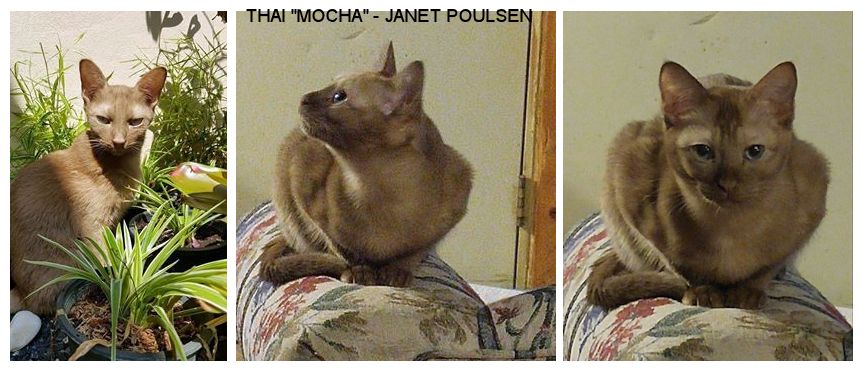
In April 2016, Janet Poulsen announced this new Thai colour is being imported into her breeding programme in Minnesota. It is speculated that Mocha is in the albino series (tentative symbol cm). If it is not on the albino series, there will be the possibility of some non-black kittens. Mating a lilac boy (CC bb dd - non-pointed, black, dilute) to the imported mocha girl (cmcm BB DD - mocha, black, non-dilute ) will establish whether the new colour gene is on the albino series and fully recessive to C (non-pointed) by producing solid black kittens. Current color tests indicate that the mocha girl is CC, meaning she should be a black cat. She looks like cinnamon but is not (genetically).
What happened to those original Luckenbough cats? According to Doug Schar, the two street cats, Amano and Marin, were cbcm cats and produce a cmcm cat called Nara while Lori had them. Amano and Marin were then “lent” to a breeder in North Carolina who in turn passed them from place to place. Doug did not know the ultimate fate of those two cats or any offspring they may have produced after they left Lori. He had several of their earlier offspring but found they had health issues and poor dispositions.
Any cmcm cats in circulation in America descend from Amano and Marin. Because of the passing from pillar-to-post, Nolan Betterly would not send any more cmcm cats to American breeders. Any breeders wanting to work with cmcm cats would have to find another source in Thailand. It seems that the breeding program based on those two cats was wiped out by FIP wipe out. In any event, the brown nose you see in the Nara photo, is what I have seen in all my cmcm cats. They start with pink noses and toes and then darken with age.
Colour tests indicate that the blue-eyed sable Burmese cats are genetically black. So far, a mating of two cbcm (tests as Ccb because there was no test yet for "mocha" cm) cats produced one cbcb, two cbcm (Ccb) and two cmcm (CC in the test available at the time). The cbcm kittens are lighter in color than the cbcb, but still pointed and within the normal color range for Burmese cats. The cmcm (CC) kittens are significantly lighter and though perhaps a bit darker on the nose, they are lighter around the eyes.
Mocha colour restriction was identified in genetically black Thai cats (now called “Bangkok” breed), hence its name. Its effect on other colours (chocolate, cinnamon, blue, lilac, fawn, red, cream) has not been investigated, but may answer long-standing questions about unusual colours reported in Thai cats.
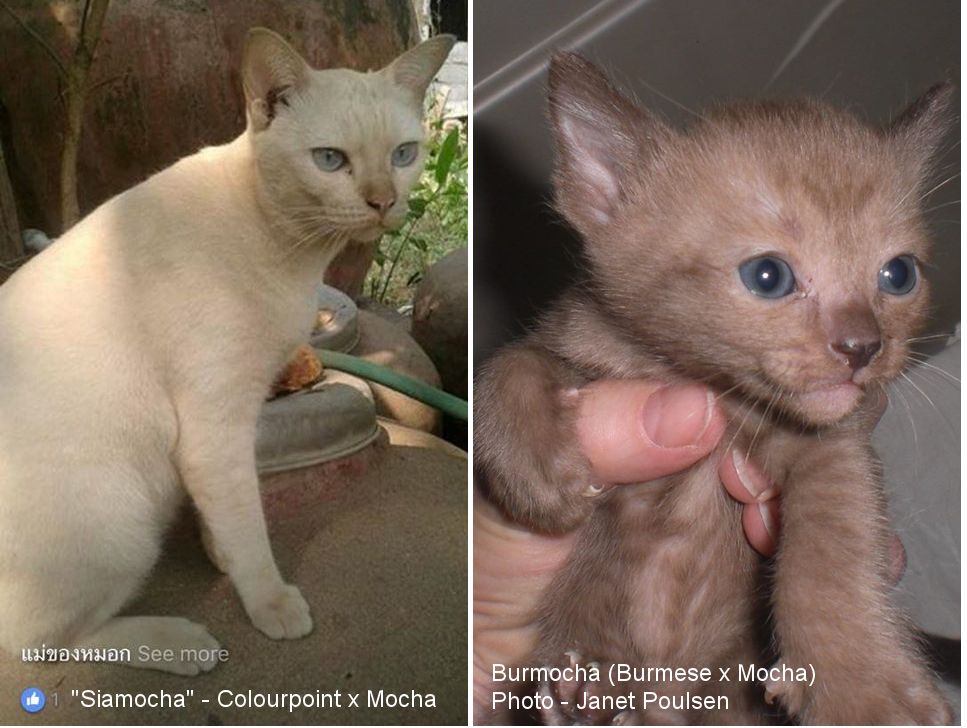
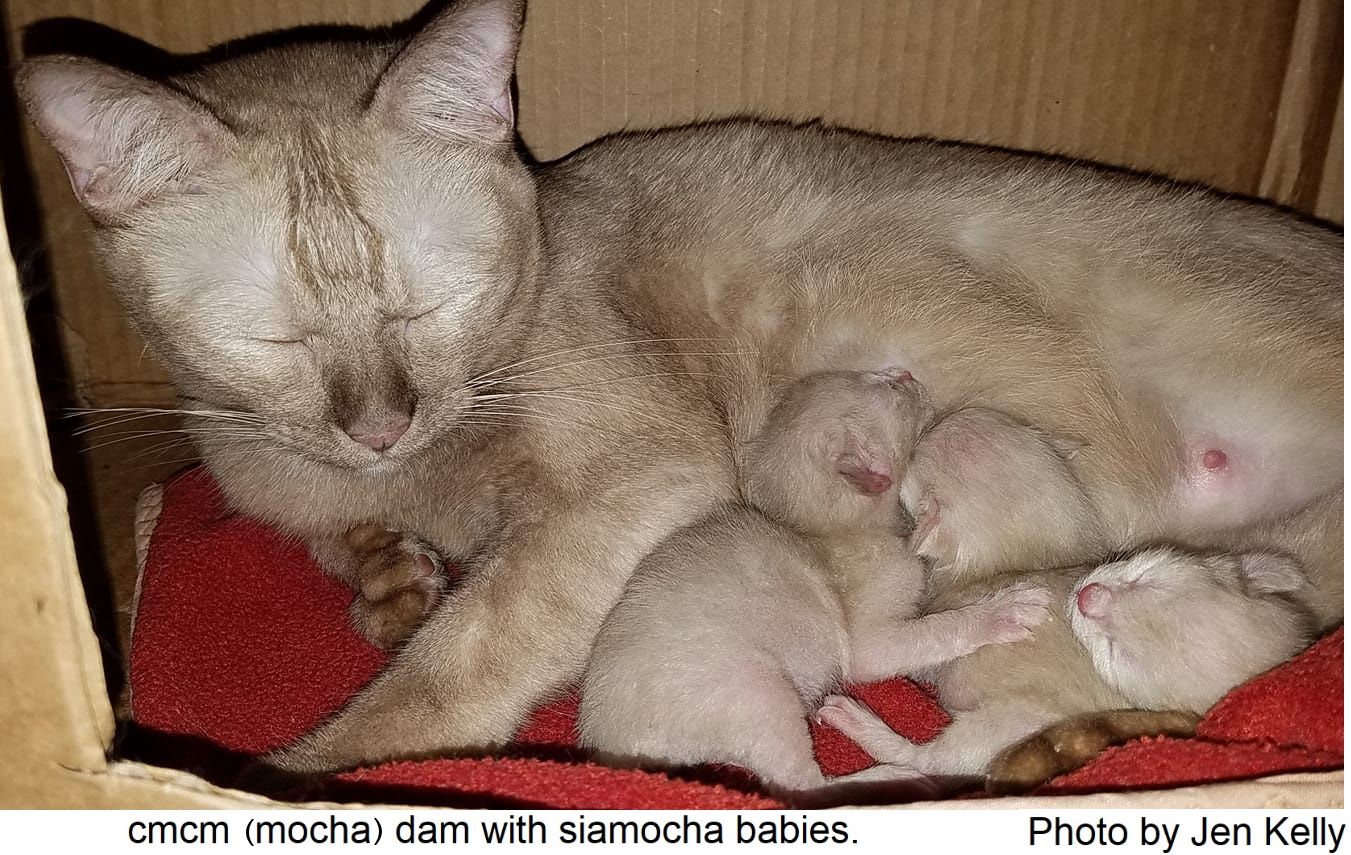
In addition to the mocha colour there are some Sable (Brown) Burmese cats with blue eyes and a kitten that might be pale blue with blue/odd eyes (ash-staining on solid white has also been suggested, but the colour is very even).
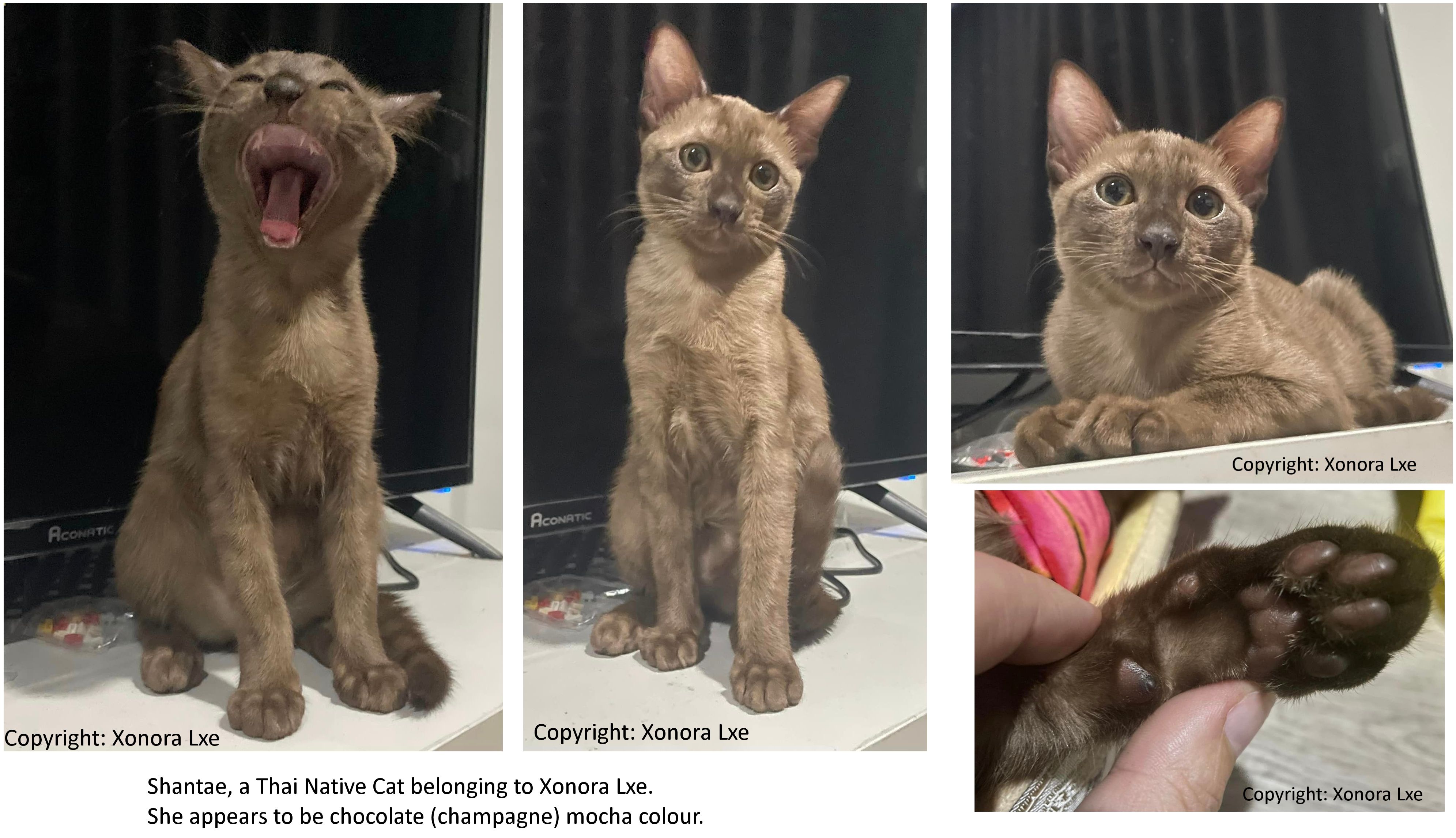
Xonora Lxe, from Pattaya, provided these photos of Shantae, a local Thai kitten, in January 2023. She is a medium brown colour with ash/pink-ash tones. She doesn’t have yellowish tones to her fur though some photos may appear that way. Next to a natural Thai Tonkinese her much cooler, “misty” fur colour and extremely low contrast is obvious. She has all 9 colourpoints but most of them are very low contrast except for the nose area and the very tips of the ears. Her paw pads are a pink-brown colour. Eyes were brown but seem to be fading to green or yellow-green by around 2 – 3 months old. The colouring and characteristic brown nose are very suggestive of chocolate (champagne) mocha (genotype bb cmcm DD).
Colourpoint varieties in diagram form. Mocha is shown as equally dominant with Burmese and Siamese colour restriction, and the Bur-Mocha and Sia-Mocha intermediates are shown in their correct places. The first cm/cm cats studiedf had "pink noses" and this was assumed to be a trait linked to the cm gene. Later imports did not always have pink noses. There can be a wide variation in phenotype of Siamocha and Burmocha - with some almost identical to Siamese and Burmese - according to temperature, season, age of cat and variable gene expression. However, Siamocha have pink-pads while Siamese have dark paw pads. The same is true for Burmocha and Burmese - Burmochas have lighter paw-pads, but the difference in nose-leather colour is less pronounced.
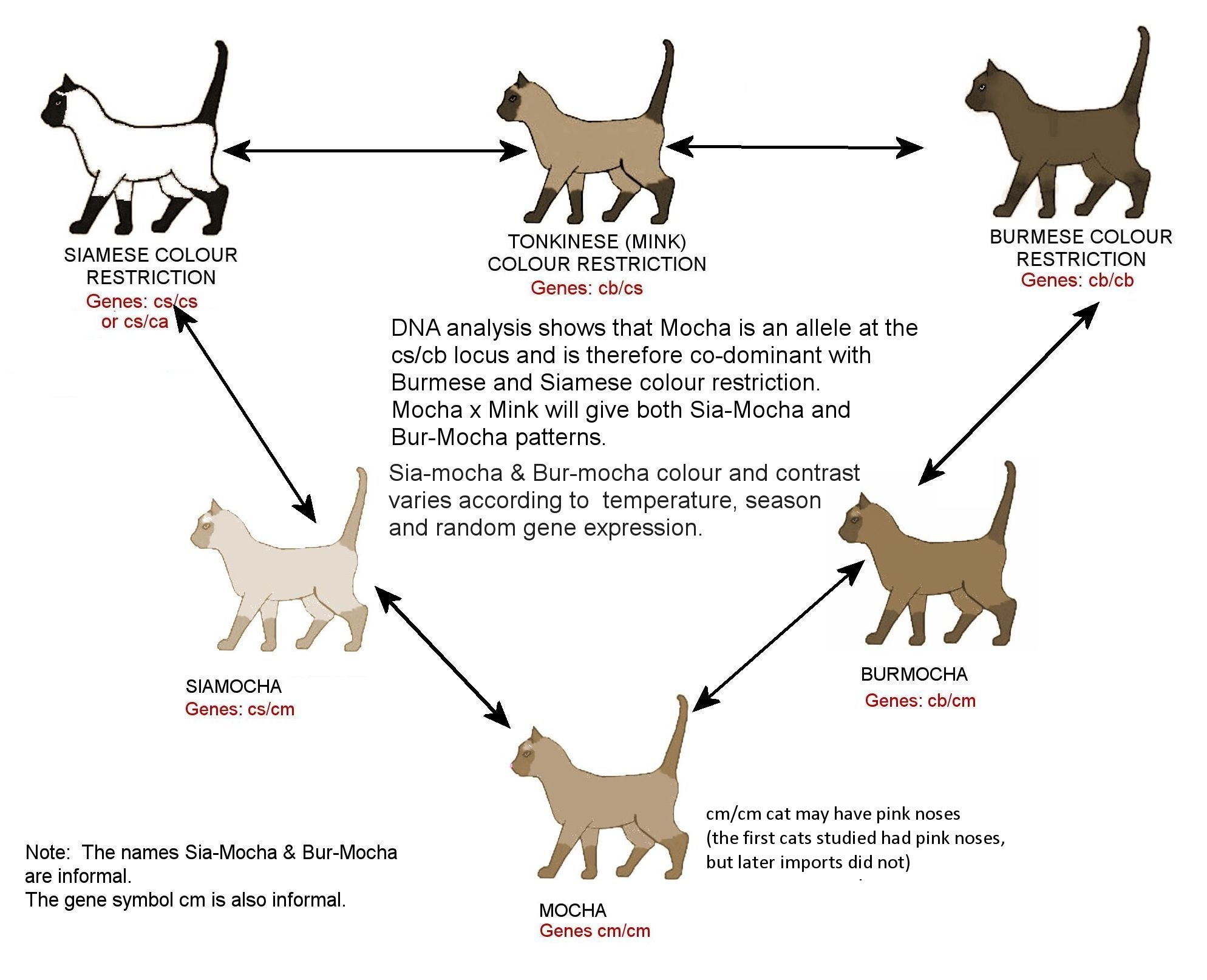
REFERENCES & OTHER INTERESTING READING